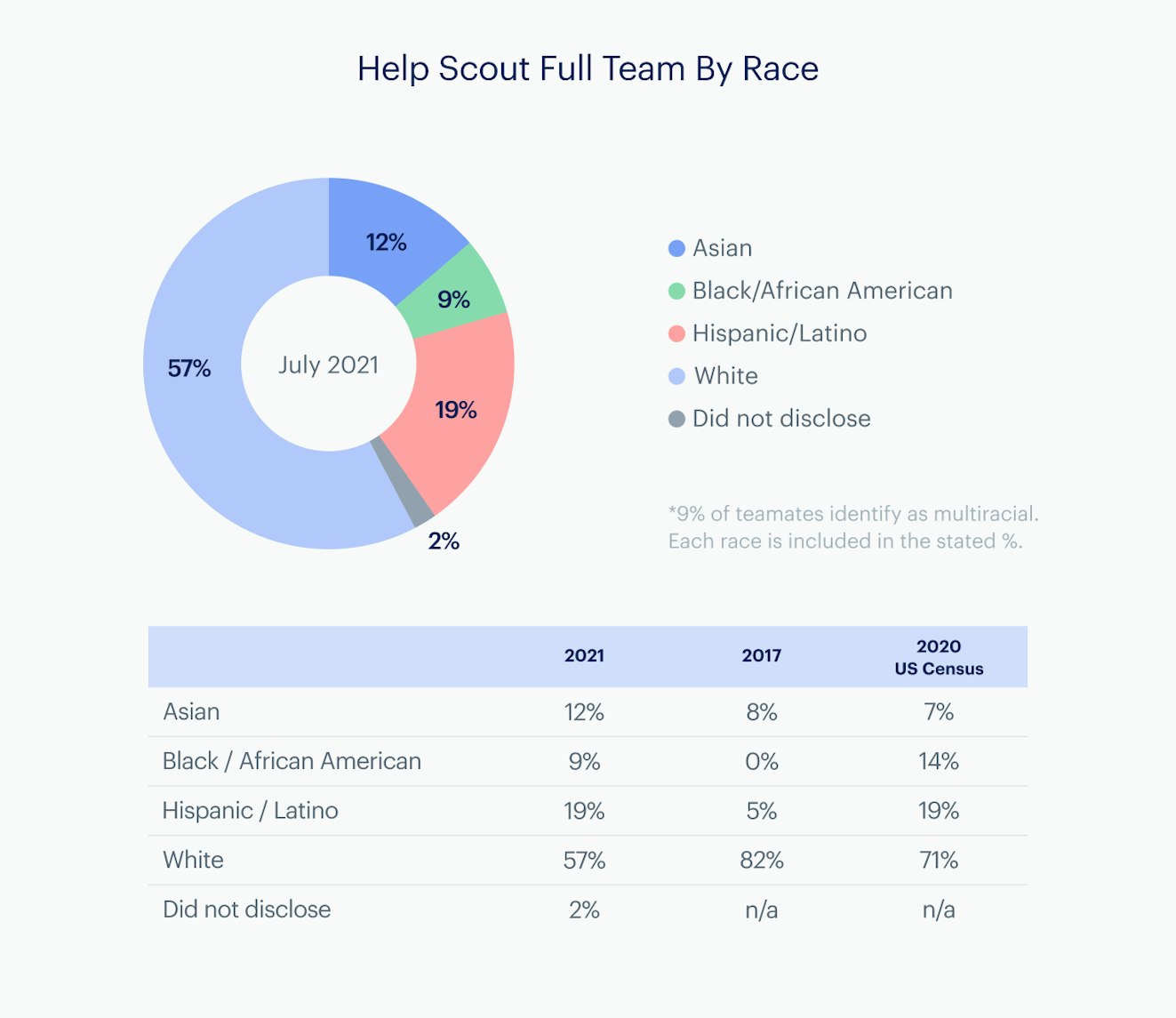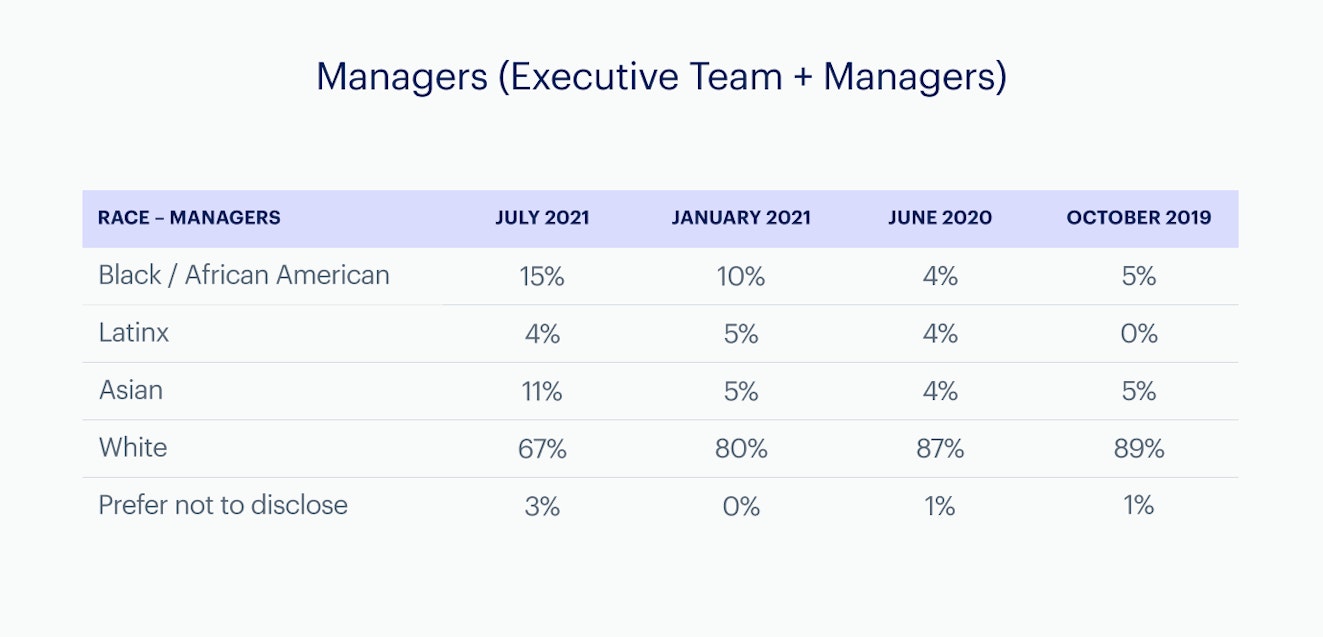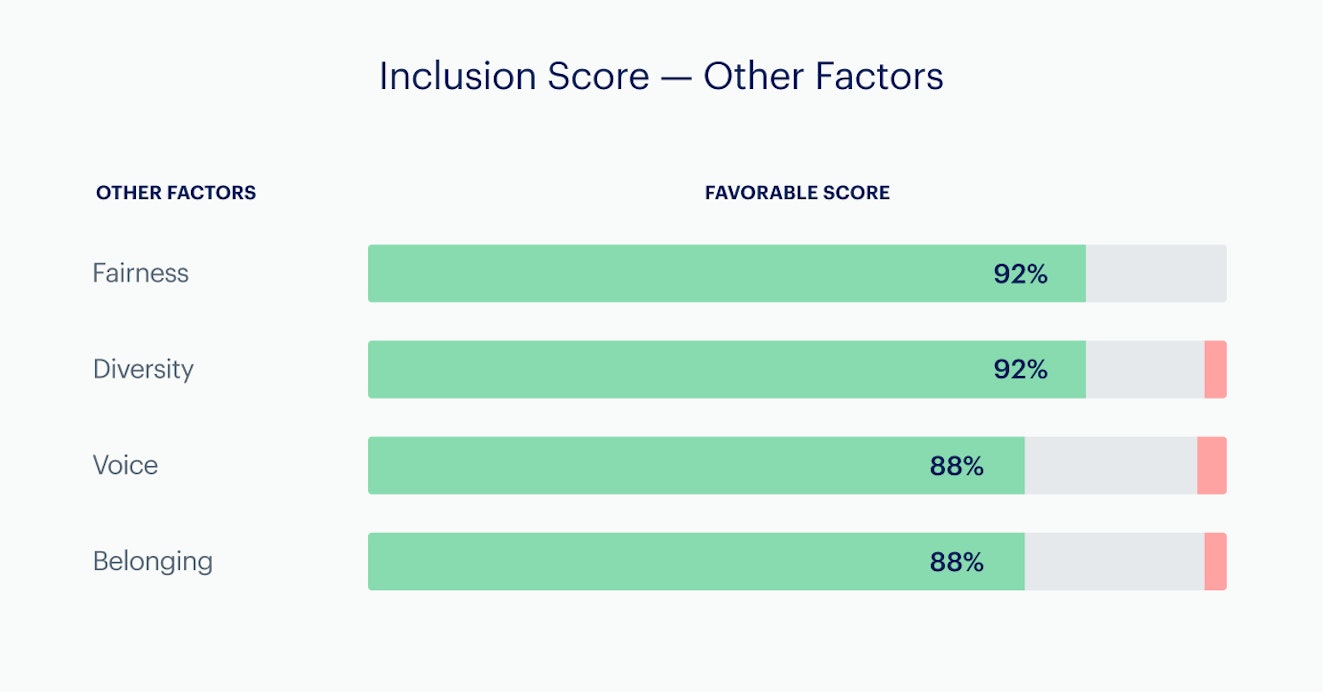It’s been a while since you’ve read about our diversity, equity, and inclusion (DEI) efforts on the Help Scout blog — in fact, it’s been since fall 2019.
While we had a lot to share in that post, both celebratory and constructive, we realized as we entered 2020 that it was time to deepen our commitment to this work and go even further. While we had seen great progress in our representation across gender, it was obvious we were falling very short when it came to representation around race, especially at the leadership level.
And then, like the rest of the world, we experienced a summer of unprecedented, coinciding events — racism and violence against Black communities in the U.S., a global pandemic, and months spent in quarantine with no clear end in sight. We continued to run biannual demographic and inclusion surveys, but we hit pause on talking publicly about this work while we turned inward to try and do better.
Now, as we enter fall 2021, we’re excited to share a new post detailing our progress, efforts, and learnings, still with the goal of keeping ourselves accountable and inspiring other companies to make serious commitments to DEI.
Getting help
Almost a year ago, in order to deepen the conversation and work with DEI at Help Scout, we realized it was time to get outside help from experts.
We partnered with Future Work Design who had expertise in helping organizations build their stamina and skills to have difficult conversations, to identify where harmful or oppressive patterns may live in the organization, and to catalyze meaningful change. We also chose to partner with them because their Equity Team includes Black and queer folks, and their organization is women-led.
Becoming accountable
While we were partnering with Future Work Design, our executive leadership team was creating our company-wide Objectives and Key Results (OKRs), which included an objective written by our CEO, Nick Francis, regarding DEI: “Take steps toward a more equitable and inclusive culture.” To make DEI efforts really work, the responsibility falls on those at the top.
In March of this year, Nick shared his thoughts on this with the entire company:
“It's less common for a leader to come out and say their culture is a piece of shit … or to get more specific, that their DEI efforts aren't good enough. For whatever reason, it's more difficult for leaders to find fault in the product they make for employees. I for one haven't always internalized our cultural weaknesses like I should have.
“For many of you, this has been a heavy and/or emotional week. Once again we're reckoning with violence in America that's directed toward people in the margins — in this case Asian-American women — and motivated by white supremacist ideology.
“Our hearts break for people affected by this sort of violence. We dearly want to be part of the solution, to support folks on our team, but we don't always know how, we don't always have the right words, and we don't always do what's right, which can only mean one thing: We have far more work to do. We have to commit to that work, both personally and as an organization.
“The culture we've built here is wonderful, but let me be clear: It is also deeply flawed and deeply insufficient for all people on this team to do their best work. Any company leader who can't admit that is lying to themselves.
“Since culture is never solved, all we can do is commit to being curious and to keep doing the work. It doesn't matter what we've tried to do or have done — we simply have more work to do and that will never change.
“It's not possible for me or anyone to offer clear answers or quick solutions to systems that marginalize people in our organization — just as it would not be possible to "solve" our product. To use a phrase I've adopted from our friends at Future Work Design in our training, we must "reject urgency but demand movement." To stop moving would be unacceptable. That implies a finish line exists, and we've already established that it doesn't.”
Setting goals and getting to work
With the company objective of “Take steps toward a more equitable and inclusive culture,” the key results were the following:
Share a 12-month DEI road map with the company.
Fill the VP of Sales and VP of People roles and broaden the leadership team’s perspectives and lived experiences.
Conduct micro-aggression training for managers in partnership with Future Work Design, and create a plan for ongoing training.
Form a crisis response committee with a mandate to respond to global and/or local events that conflict with our mission and who we want to be as a company.
Here’s the progress we’ve made toward those goals as of October 2021.
Key Result #1: Share a 12-month DEI roadmap with the company
Nick created a DEI road map in a public Asana board that was shared with the company during a town tall meeting. It was critical to establish a way to be more transparent and visible about the work being done across the organization and to keep everyone in the loop. He also went over the items on the road map in our September town hall to give updates on our progress.
Key Result #2: Fill the VP of Sales and VP of People roles and broaden the leadership team’s perspectives and lived experiences
At the time of the creation of this KR, our executive leadership team had been lacking racial diversity since 2019, which didn’t accurately represent our customers, our larger team, or where we wanted to be.
In clearer terms, the executive team was all white, which meant critical points of view and lived experiences were not being represented at our most senior levels. Opportunities to fill seats on our executive leadership team are few and far between, so when we found ourselves with the chance to fill two seats, we lit the fire.
To help us invest in finding the best candidates for these roles, we needed to supercharge our efforts with external help. We partnered with AboveBoard, an executive search platform with a focus on underrepresented executive-level talent, and we partnered with true, a leading executive search firm.
We knew finding the right candidates would take time, especially in today’s competitive candidate market, and we prepared to stay committed to this KR. This commitment resulted in over 700 sourced candidates and about 50 people entering our hiring process for these roles.
In the end, our VP of Sales hire took 180 days and our search to find our first ever Chief People Officer took us 329 days (no, that is not a typo). We are ecstatic about the people we hired and are proud we stayed the course.
Key Result #3: Conduct micro-aggression training for managers in partnership with Future Work Design, and create a plan for ongoing training
The first part of the work with Future Work Design involved having all of our managers go through their foundational workshop consisting of six 90-minute sessions, where we were able to align as leaders about the what and the why to our commitment to DEI. Following the foundations workshop, all managers went through another series of workshops to understand and interrupt micro-aggressions in the workplace.
These workshops were eye-opening to say the least, and they began deeper conversations and actions that hadn’t previously been happening. We started with managers, since this group is in a position of power and largely responsible for systemically effecting change.
As I’m writing this, the entire company is now going through both of these workshops in order to deepen our commitment to DEI and to keep moving this work forward.
Key Result #4: Form a crisis response committee with a mandate to respond to global and/or local events that conflict with our mission and who we want to be as a company
The summer of 2020 saw headline after headline about racial violence, natural disasters around the world, and a growing pandemic. It felt important to our company leaders to communicate to the company, and at times publicly, to show support and solidarity for our team and the communities we care about. But it felt challenging to always know how, when, and what to say.
With the help of Future Work Design, we came up with the idea to create a crisis response committee. It would be a paid opportunity for teammates from different demographics to come together and serve as a response team to help shape and guide Help Scout’s response, acknowledgement, and support for our employees during times of crisis.
This team would go to work when global or local happenings were in direct conflict with our mission, who we want to be as a company, and how we want to support our team members. It was also important that the makeup of this committee change every 6 months so as not to overburden any one individual and to provide opportunities for new voices to contribute.
It was also important to us that this work be paid in addition to regular salary — so often the work of moving equity in an organization falls on the unpaid labor of those who hold the most marginalized identities. We wanted to ensure that any work that makes us a better organization would be compensated.
Teammates who wanted to participate filled out a brief application and the first six members were recently chosen. As we speak, the committee has finished shaping their mission and vision and will soon share that with the larger company before officially being established.
Additional efforts
While not tied to specific KRs, It was also important to us to think of other ways to make our company and culture more inclusive across teams.
First, our support and product teams looked at the language used in Help Scout’s product and made what might seem like a small but significant change to a popular feature.
For many years, “traffic cop” prevented support teams from duplicating replies, but as part of the work of analyzing how our language impacts people, we realized “cop” might not be a friendly word to everyone. We renamed it “collision detection,” a clearer explanation of the feature, and we updated all marketing materials, documentation, and in-app experiences (mobile and web).
Second, to make sure our candidates were being treated with respect and being fairly assessed, our Talent Acquisition team created our own in-house interviewer training that included unconscious bias pitfalls and strategies to mitigate them. We began publicly sharing salary ranges on job descriptions to be more transparent and to prevent salary disparities that can happen more often for underrepresented groups.
The data is in
We conducted our most recent demographic and inclusion survey in July 2021, and we were excited to see several important changes, as well as the comparative change that has happened overall since we started this work in 2017. You can see all of the demographic data by checking out our public, transparent dashboard.
Demographics

Help Scout is the most racially diverse it has ever been, and our numbers closely resemble the data from the most recent 2020 U.S. Census.
At the leadership level, our Executive Leadership team is now 86% white and 14% Black. Racial diversity at the manager level is also higher than in any previous year.

Inclusion
Demographics are only one piece of the puzzle — we also pay close attention to the data that we receive from the inclusion portion of the survey, and were proud that our scores went up in almost every area.

Overall, our inclusion scores remain high, with fairness and diversity scores above 90, and we saw increases in all measured factors.
We were also excited to see increased scores around the following statements:
"I can voice a contrary opinion without fear of negative consequences." We saw a 13 point increase to 82%, up from 69% in January.
"Even when something bad happens (e.g., when I get critical feedback from my manager, I have a negative social interaction with a peer, etc.), I don’t question whether or not I belong at Help Scout." We saw a 9 point increase to 85%, up from 76% in January.
We’re optimistic, and we believe these increased inclusion scores are likely a result of the company’s deeper commitment to DEI in authentic, meaningful ways.
What’s next?
While it feels good to see some significant changes taking place at Help Scout, we know the work is never done, and there will always be room for more improvement.
For example, our Engineering team is currently 29% women and 2% non-binary, and we hope to focus our efforts to increase representation on our largest team. To help address this, we are hiring our first ever in-house sourcer to increase our recruiting efforts and to uncover even more outstanding underrepresented talent.
We also have plans to form a paid DEI committee made up of teammates from different departments and backgrounds to help spearhead further initiatives.
Our journey to make Help Scout a company where all identities can thrive has taken many turns and hit many potholes along the way. But what’s truer now than ever before is a company-wide, leadership-supported approach to keep DEI at the forefront and as the lens we use as we continue building this business.
And did I mention we’re hiring?

